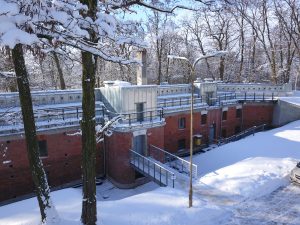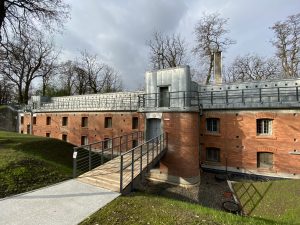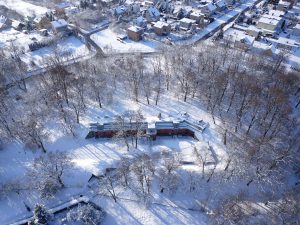Headquarter
The headquarters of the Centre for Documentation of Deportations, Expulsions and Resettlements – Fort No. 52 and ½ N “Skotniki” – is part of the Krakow Fortress Route. The design of this facility was made by a distinguished engineer in the service of the CK Army – Emil Gologorski. It is one of the twin inter-field, small armored Forts, which were built in the years 1897-1898 in Skotniki and formed typical Close Defense Forts. Their construction seemed necessary already in the 1880s due to the great distance between Forts 52 “Borek” and 53 “Bodzow”. Forts 52 and ½ N and S belonged to the VIII defense sector.
This fort was a typical work of Austro-Hungarian engineering representing the Armored Forts of the late 19th century. Their features include a courtyard, an oval outline, a moat with a flattened slope, the frontal location of the shelter-combat block and the provision of forebays for infantry. Further mention can be made of an earthen rampart with infantry positions, a dry moat with a flattened slope, an entrance protected by a gate, bars and a single-room shelter-fort. Fort Skotniki had two towers for M94 8 cm cannons made by Emil Škoda. These cannons were unfortunately scrapped after 1945. The fort has an observation tower, which was armed with machine guns. The walls, which are more than half a meter high, are brought from so-called Zendrowka bricks, which were bonded together with a very strong mortar with added protein. Thick ceilings, on the other hand, were created from thick concrete – its recipe was strictly secret. These ceilings were built on thick metal piles and were covered with corrugated metal sheets. An insulated layer of bricks was laid on top of the concrete, followed by asphalt and only clay, stones and earth. The Fort’s crew did not take part in the battles for Krakow during World War I. Subsequently, it fell into the hands of the Polish army.
During the German occupation of 1939-1945, the site was used as a prison for Red Army prisoners of war who were building Stalag No. 369, intended for the French, Belgians and Dutch. Soviet prisoners of war died of exhaustion and from dire living conditions. The thick walls of the Fort did not let the frost pass so easily, but the rooms were not heated either. It should be added here that the prisoners had been in the Fort since February 2, 1942, and were ill with typhus, cold, scurvy and diarrhea. In total, about 160 soldiers died at the Fort. They were buried on the outskirts of the Fort, and after the war their bodies were moved to a mass grave next door. It is possible that among them were Poles who were forcibly enlisted in the Red Army. During this tragic war, there must have been some military operations at the Fort, as evidenced by a mortar shell found in a ventilation shaft during the renovation of the facility.
After World War II, the Fort was in use all the time. Before 2011, it was in the hands of the Malopolska Regional Office. In 2017. The fort became the property of the University of the Commission of National Education in Krakow. Over the past few years, its external renovation was carried out, as a result of which it was restored to its original appearance.


